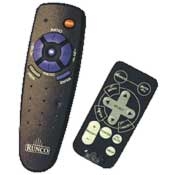Seeing the Digital Light Page 5
Runco's DLP Front Projector
 Who invented home theater? Although lots of companies would like to claim to have been the first to deliver a taste of the movie theater experience in the home, a good case can be made for Runco. As far back as 1991, the company pioneered aspect ratio control for CRT front projectors so that widescreen movies on laserdisc could be viewed at home in a theatrical format. With widescreen HDTVs on the market now, aspect ratio control is something we take for granted, but when Runco first developed it, it was a revolutionary idea.
Who invented home theater? Although lots of companies would like to claim to have been the first to deliver a taste of the movie theater experience in the home, a good case can be made for Runco. As far back as 1991, the company pioneered aspect ratio control for CRT front projectors so that widescreen movies on laserdisc could be viewed at home in a theatrical format. With widescreen HDTVs on the market now, aspect ratio control is something we take for granted, but when Runco first developed it, it was a revolutionary idea.
A decade later, Runco is still pushing the home theater envelope with DLP projectors like the VX-1c, which includes the outboard VHD video processor/aspect ratio controller. Licensing agreements previously prohibited Texas Instruments from selling 16:9 aspect ratio DMDs to front-projector manufacturers, but that didn't stop Runco, which developed a neat workaround in the VHD. The VX-1c's 4:3 aspect ratio DMD has a native resolution of 1,024 x 768 pixels. If the projector is mated with a screen that has a wide aspect ratio, however, the VHD controller scales images down to a 16:9 area on the DMD's surface. This allows the VX-1c to operate like a native widescreen display, switching effortlessly between HDTV, anamorphic widescreen DVDs, and standard 4:3 sources.
Although the VX-1c/ VHD package consists of two separate, stylistically undistinguished pieces, the way they seamlessly communicate is a thing of beauty. A phone-type cable carries commands from controller to projector -- press the power button on the controller's remote, and the entire system turns on. And once you've set up the projector on a table or the ceiling and aligned its lens with the screen, you can forget about it and turn your attention to the VHD controller.
Inputs on the VHD include composite-, component-, and S-video jacks. Although the component-video jack won't accept signals from a progressive-scan DVD player, the VHD's scaler, which features 3:2 pulldown for film-based video sources, performs as well as the best progressive-scan DVD players I've tested. A 15-pin VGA-jack pass-through input lets you connect an HDTV tuner, and there's an RGB+ H/V output to the projector.
Having labored for hours setting up CRT front projectors in the past, I found getting the VX-1c to look good absurdly easy. After positioning it so its image filled a 92-inch 16:9 Da-Lite High Contrast Da-Mat screen, which is designed specifically for DLP projection, I selected the warmest setting on the projector's slider-type color-temperature control and used the Avia disc to adjust the picture settings on the VHD.
With the Runco VX-1c projecting Gladiator, I felt as though I was sitting beside Emperor Commodus in the Colosseum during the movie's bloody battle scenes -- the image was that crisp, lifelike, and large. And the combined one-two punch of the VHD's clean video processing and the Da-Lite screen's contrast enhancement delivered satisfying shadows in the movie's dark opening scenes. Although the contrast wasn't as punchy as from the $25,000 Runco DTV-991 CRT projector we use in our reference video system, the VX-1c's overall brightness was nearly double -- and that's with an even larger screen than we normally use!
| Runco VX-1c/VHD |
KEY FEATURES
DIMENSIONS VX-1c projector, 14 1/2 inches wide, 5 3/4 inches high, 18 1/2 inches deep; VHD controller, 17 1/2 inches wide, 13/4 inches high, 11 inches deep WEIGHT VX-1c projector, 21 pounds, VHD controller, 7 1/2 pounds PRICE $16,995 MANUFACTURER Runco, Dept. S&V, 2463 Tripaldi Way, Hayward, CA 94545; www.runco.com; 800-237-8626 |
On the other hand, the projector could use a little improvement with its color rendition. It has a single global color-temperature control, so there's no easy way to achieve a precise grayscale. I found the colors vibrant and reasonably accurate in both the Gladiator DVD and the high-def satellite transmission of The Talented Mr. Ripley, but in a few scenes the flesh tones were a bit too orange.
Runco's VX-1c/VHD controller combo is a great choice if you want the ultra-big-screen experience of a front projector along with DLP's simplicity and eye-pleasing brightness. The VHD controller in particular deserves praise for its seamless integration with the VX-1c projector. I was also impressed by its high-quality scaling and the clever way of adapting the projector's native 4:3 aspect ratio DMD for widescreen display. CRT-based projectors might still dominate home theater's high end, but with the arrival of DLP projectors like the Runco VX-1c/VHD system, that could soon change.
Will your next TV be a DLP projector? That depends on the progress Texas Instruments makes in getting the word out about its technology and getting the price of DLP displays down to more affordable levels. To judge by these offerings from Hitachi and Runco, DLP is closing in on the CRT. It's only a matter of time before the traditional TV tube becomes a thing of the past.












































